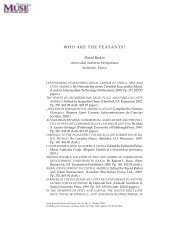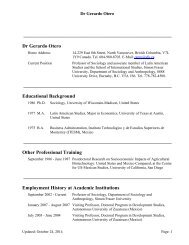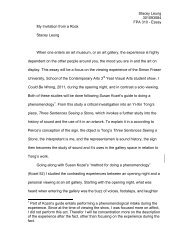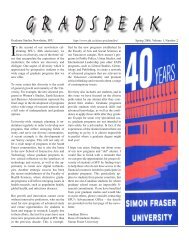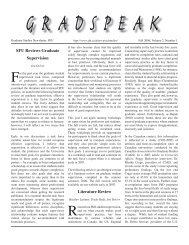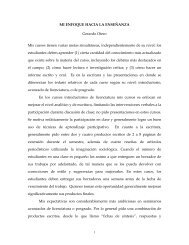Link - Simon Fraser University
Link - Simon Fraser University
Link - Simon Fraser University
You also want an ePaper? Increase the reach of your titles
YUMPU automatically turns print PDFs into web optimized ePapers that Google loves.
644 M. W. Hart and P. B. Markocomprehensive framework for understanding thetrade-offs between larval transport and larval losses.A key feature of this framework is Strathmann’ssuccessful argument that planktonic larvae are generallyoverdispersed relative to the distribution ofsuitable benthic habitat, and that individual adultsgain few (if any) short-term benefits from the obligatelong-distance planktonic dispersal of their offspring(Strathmann 1985). However, most larvalbiologists would probably agree that variation inlarval developmental modes, and the expected variationin gene flow between populations that arisesfrom the dispersal potential of different developmentalmodes, has important consequences overlonger ecological and evolutionary timescales. Forthis reason, population geneticists have focused onmarine species as model systems for understandingthe impacts of life-history variation on realized dispersalor gene flow between populations. An importantreason for the focus on life-history correlates ofdispersal is the extraordinary expected variance inlarval dispersal potential among species with differentmodes of development and potentially among conspecificlarvae with the same mode of development.In species with slow-growing planktotrophic larvae,siblings are predicted to diffuse large distances fromeach other with a high variance in dispersion fromthe natal habitat, whereas offspring with benthic developmentare predicted to recruit to their natal habitatalong with many of their siblings. Other thingsbeing equal, such differences in mode of developmentand larval dispersal potential are expected tostrongly affect important demographic measures includingfunctional sex ratio, effective population size,gene flow, population persistence and colonization(i.e., metapopulation dynamics), probability of extinction,and rate of speciation. Most recently, conservationbiologists (Fortuna et al. 2009) havefocused on life-history differences as predictors ofpopulation connectivity, metapopulation dynamics,and capacity for recovery from, or local adaptationto, disturbance by humans.Is variation in larval developmental mode (and ingene flow by larval dispersal) the prime determinantof genetic drift and population differentiation?Marine phylogeographers have put extraordinaryeffort into answering this question through the analysisof the spatial distribution of genetic variationwithin and between populations. Because the effectsof developmental mode act in the context of theoverall phenotype of the organism and the historicalbiogeographical context of its environment, the mostpowerful tests of the relative effect of evolutionarychanges in mode of development on populationgenetic variation have used comparisons betweenclosely related species that share otherwise similarphenotypes, or members of the same community thatshare a similar biogeographical context (Bohonak1999).Starting with the earliest comparative studies ofmarine population genetic structure (Berger 1973),a steady stream of comparative analyses has yieldedresults consistent with the predicted effects of differentmodes of larval development (regardless of otherphenotypic or biogeographical effects), such as strongerpopulation differentiation, smaller effective populationsize, or striking phylogeographic breaks inspecies with lower larval dispersal potential (e.g.,Janson 1987; Waples 1987; McMillan et al. 1992;Duffy 1993; Hunt 1993; Shulman and Bermingham1995; Hellberg 1996; Arndt and Smith 1998; Toddet al. 1998; Kyle and Boulding 2000; Collin 2001;Watts and Thorpe 2006; Sherman et al. 2008; forreviews see Gooch 1975; Crisp 1978; Burton andFeldman 1981; Palumbi 1994; Bohonak 1999;Kinlan and Gaines 2003). At the same time, however,there has also been a slow accumulation of a numberof exceptions in which either unexpectedly stronggenetic differentiation has been found over relativelysmall geographic scales in species with planktoniclarvae (Koehn et al. 1980; Barber et al. 2000;Buonaccorsi et al. 2002; Taylor and Hellberg 2003a;Sotka et al. 2004; Marko and Barr 2007; Marko et al.2007) or an absence of genetic subdivision over largeareas has been found in species without a planktoniclife-history stage (Kyle and Boulding 2000; Marko2004; Ayre et al. 2009; for reviews see Burton andFeldman 1982; Burton 1983; Cunningham andCollins 1998). For the most part, strong differentiationin species with planktonic larvae has usuallybeen attributed to natural selection acting directlyon genetic markers (Koehn et al. 1980; Sotka et al.2004), nearshore oceanographic processes (Gilgand Hilbish 2003; Sotka et al. 2004; Marko andBarr 2007; Banks et al. 2007), habitat specificity(Ayre et al. 2009), or larval behavior (Warner andPalumbi 2003) whereas genetic homogeneity inspecies lacking broadly dispersing planktonic larvaecould reflect recent population expansions (Edmands2001; Marko 2004), stabilizing selection (Karl andAvise 1992), or unexpected dispersal capability(e.g., by rafting of adults, juveniles, or encapsulatedembryos attached to mobile substrates such as birdsor kelps) (Highsmith 1985; Helmuth et al. 1994).Although the degree of differentiation (or absenceof differentiation) in many of these cases is striking,it is important to note that many of these exceptionalstudies involve single species (a situationDownloaded from icb.oxfordjournals.org at <strong>Simon</strong> <strong>Fraser</strong> <strong>University</strong> on November 2, 2010



